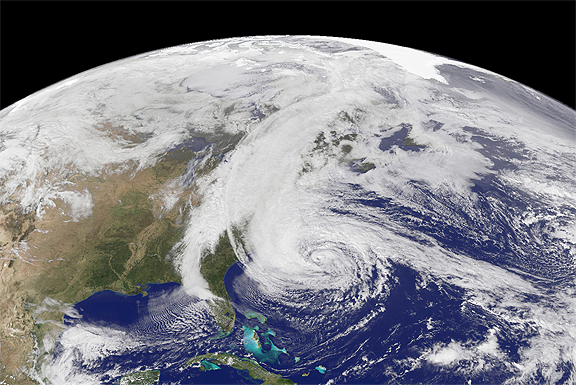This week we have a guest blogger, Dr. Dixon Butler. Dr. Butler was the GLOBE Chief Scientist from 1996-2003 and now works as a consultant to NASA.
One of the most significant technology improvements in modern life is our ability to accurately forecast future events. Weather forecasts now routinely extend for five days. The recent flooding on the East Coast of the United States was forecast days in advance. The cause was an unusual merger of two storms to create a super storm – Super Storm Sandy. Atmospheric models correctly predicted that a winter storm coming from the north and a weakening tropical storm Sandy would merge with disastrous results.

GOES-13 Image of Super Storm Sandy on 28 October 2012. Image courtesy of NASA
In 1976, models of the stratosphere predicted significant depletion of the ozone layer and consequent increases in harmful ultraviolet sunlight reaching Earth’s surface. Manmade chlorofluoromethanes – chemicals with one carbon atom plus chlorine and fluorine atoms – were identified as the cause, and their use as spray can propellants was banned. This led to reductions in the use of these compounds. When the Antarctic ozone hole was discovered years later and all use of them was banned, there were less of these chemicals in the atmosphere. The ozone layer is now recovering, but this process will continue for more than a century.

A look at the ozone hole located over Antarctica. Image courtesy of NASA
We now recognize that our activities can have worldwide lasting effects. We also have more and more skill in predicting the effects of our activities. This skill depends on better measurements, taking measurements at finer spatial scales, building more powerful computer models of the environment, and pushing these models to finer spatial resolution.
Climate is long-term by definition. Generally questions of climate involve averages of conditions (e.g., rainfall, atmospheric temperature) over 30-year periods and longer as well as the likelihood of extreme events such as tropical storms, blizzards, and droughts. We humans are always making decisions that depend on what we think future climate will be. In the past, societies generally based decisions on the expectation that the climate would not change. When this proved wrong, whole societies disappeared or radically changed their cultures and economies.
Some decisions about how and where we live and locate our different activities can now be made taking into account predictions of future climate, but many long-term decisions cannot rely on current predictions because they are not accurate enough and they don’t provide guidance at fine enough scales. For instance, almost every human settlement is adjacent to a water body – a river, lake, or ocean. In planning for the future, everyone would benefit from knowing where future floods will occur. No one wants to build a factory, shop, or home where there will be flood damage every few years during the useful life of the building.
GLOBE data can contribute to improving future forecasts and our ability to adapt to a changing climate. Measurements that provide data on finer special scales are required to enable accurate models and predictions at these scales. By adding a wealth of data covering where we live in more detail, GLOBE students are doing their part to help better decisions about where we choose to live and work in the future – to help us all adapt to climate change.
